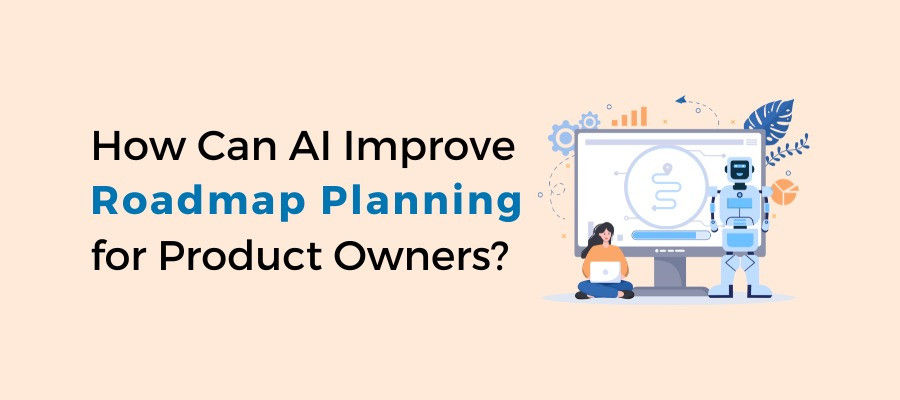AI for Product Owners - How Can AI Improve Roadmap Planning for Product Owners?

Roadmap planning is where a Product Owner's strategic vision takes shape. It translates business goals into actionable plans that inspire stakeholders and empower teams. However, this task is far from simple. It demands balancing customer needs with market dynamics. It focuses more on development realities while ensuring alignment with the company goals.
For Certified Scrum Product Owners (CSPOs), AI offers the tools to create roadmaps that are not just comprehensive but also adaptive and data-driven. Let’s explore how AI can elevate roadmap planning for Product Owners and deliver greater organizational value!
AI Helps In Simplifying Market Research
Roadmap planning begins with understanding the market—its trends, competitors, and customer demands. AI tools excel at analyzing massive datasets quickly and delivering actionable insights.
Here’s how AI enhances market research for Product Owners:
- Trend prediction: AI tools like Crayon or SimilarWeb track emerging industry trends, helping you anticipate market shifts.
- Competitor analysis: Platforms like Crux Intelligence provide competitive insights by analyzing product releases, pricing strategies, and customer feedback.
- Customer sentiment analysis: Tools like MonkeyLearn scan reviews and social media to gauge customer sentiment, uncovering pain points and desires.
With these insights, Product Owners can create roadmaps that resonate with customer needs and stay ahead of the competition.
Prioritizing Features With Data-Driven Insights
Feature prioritization is at the heart of roadmap planning, but it’s rarely straightforward. AI clarifies this process by analyzing key data points and offering recommendations.
How AI helps in feature prioritization:
- Value vs. effort matrix: AI-powered tools like Aha! Analyze feature requests against factors like customer impact, development effort, and revenue potential to rank features effectively.
- User behavior analysis: Platforms like Pendo or Heap use AI to study user behavior, identifying which features users value the most.
- Predictive analytics: AI forecasts the potential success of new features based on historical data, allowing you to make more informed decisions.
These insights empower Product Owners to prioritize features that maximize customer satisfaction and business value.
Enhancing Collaboration Across Stakeholders
Building a roadmap isn’t a solo endeavor—it requires buy-in from stakeholders across teams. AI simplifies collaboration by providing visual tools and automating communication.
Here’s how AI fosters better stakeholder collaboration:
- Interactive roadmaps: Tools like ProductPlan or Roadmunk use AI to create visually engaging, real-time roadmaps that are easy to share and update.
- Scenario modeling: AI simulates multiple roadmap scenarios, allowing stakeholders to weigh trade-offs before committing to a plan.
- Automated updates: AI bots inform stakeholders by sending regular progress updates or alerts when deadlines shift.
This ensures everyone stays aligned, reducing friction and increasing trust in the Product Owner’s vision.
Managing Risks Proactively
Unforeseen challenges are inevitable in any project, but AI can help Product Owners anticipate and mitigate risks before they escalate.
AI’s role in risk management includes:
- Identifying dependencies: AI tools like Jira Align highlight dependencies between roadmap items, ensuring no tasks are overlooked.
- Forecasting delays: Predictive models warn of potential delays by analyzing factors like resource allocation and past project performance.
- Assessing resource constraints: AI evaluates team capacity against roadmap timelines, helping you avoid over-committing.
By managing risks early, Product Owners can keep their roadmaps realistic and achievable.
Creating Adaptive Roadmaps
Traditional roadmaps can feel rigid, struggling to keep pace with the fast-changing world of Agile development. AI enables the creation of adaptive roadmaps that evolve with new information.
How adaptive roadmaps benefit from AI:
- Real-time updates: AI tools automatically adjust roadmaps based on changes in priorities, team capacity, or market conditions.
- Goal alignment: Platforms like Airfocus use AI to ensure roadmap items align with high-level business objectives.
- Customer feedback integration: AI continuously incorporates customer feedback into the roadmap, ensuring it remains relevant and user-focused.
This adaptability allows Product Owners to respond swiftly to change, turning challenges into opportunities.
Visualizing Roadmap Success With AI
Presenting a roadmap is as important as building one. Stakeholders want to see not just what’s planned but also why it’s important. AI enhances roadmap visualization by creating compelling narratives supported by data.
Key features of AI-driven roadmap visualization:
- Impact forecasting: AI showcases the expected outcomes of each roadmap item, making the business case for priorities.
- Milestone tracking: AI highlights key milestones and tracks progress toward goals in real-time.
- Data-backed storytelling: Tools like Tableau or Power BI integrate roadmap visuals with actionable insights, making your presentation more persuasive.
With these capabilities, Product Owners can communicate their vision more effectively, securing stakeholder confidence and enthusiasm.
Gear Up For The New Era Of Roadmap Planning Using AI
Roadmap planning has always been both an art and a science. With AI, the science becomes sharper, leaving Product Owners free to focus on the art—the strategic thinking, stakeholder alignment, and creative problem-solving that no algorithm can replace.
Mastering AI tools for roadmap planning can be a game-changer for Product Owners pursuing the Certified Scrum Product Owner (CSPO) certification. These tools don’t just make the process faster—they make it more intelligent. From prioritizing features to managing risks, AI transforms roadmap planning into a strategic, data-driven exercise.
PremierAgile’s CSPO training programs are designed to help you embrace this transformation. With a focus on Agile principles and the integration of modern tools like AI, these programs prepare you to lead with confidence and innovation. So, enroll in and elevate your roadmap planning skills with PremierAgile!
Reference:
Unlocking the Power of AI in Product Management: A Comprehensive Guide for Product Professionals | by Nima Torabi | Beyond the Build | Medium




